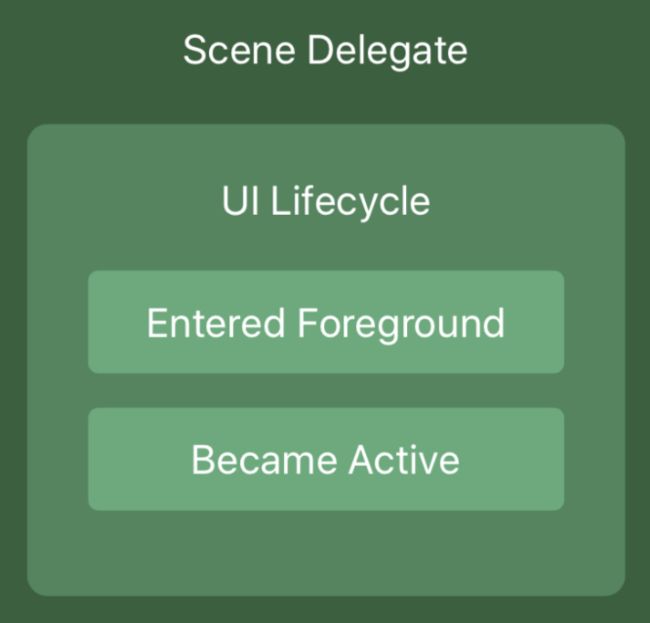SceneDelegate是为了支持 iOS13之后的 iPadOS 多窗口口而退出的。Xcode11 默认会创建通过
UIScene管理多个 UIWindow 的应用,工程中除了 AppDelegate 外会多一个 SceneDelegate。并且 AppDelegate.h 不再有 window 属性,window 属性被定义在了 SceneDelegate.h 中,SceneDelegate 负责原 AppDelegate 的 UI 生命周期部分的职责。
-
iOS13之前
AppDelegate的职责全权处理 App 生命周期和 UI 的生命周期。
这种模式完全没有问题,因为只有一个进程,只有一个与这个进程对应的用户界面。
- iOS13 之后
AppDelegate 的职责是处理 App 的生命周期;
新增的 SceneDelegate 是处理 UI 的生命周期。
- Xcode11 新建项目的 AppDelegate 文件
import UIKit
@UIApplicationMain
class AppDelegate: UIResponder, UIApplicationDelegate {
func application(_ application: UIApplication, didFinishLaunchingWithOptions launchOptions: [UIApplication.LaunchOptionsKey: Any]?) -> Bool {
// Override point for customization after application launch.
return true
}
// MARK: UISceneSession Lifecycle
func application(_ application: UIApplication, configurationForConnecting connectingSceneSession: UISceneSession, options: UIScene.ConnectionOptions) -> UISceneConfiguration {
return UISceneConfiguration(name: "Default Configuration", sessionRole: connectingSceneSession.role)
}
func application(_ application: UIApplication, didDiscardSceneSessions sceneSessions: Set) {
}
}
- Xcode11 新建项目的 SceneDelegate 文件
class SceneDelegate: UIResponder, UIWindowSceneDelegate {
var window: UIWindow?
func scene(_ scene: UIScene, willConnectTo session: UISceneSession, options connectionOptions: UIScene.ConnectionOptions) {
// Use this method to optionally configure and attach the UIWindow `window` to the provided UIWindowScene `scene`.
// If using a storyboard, the `window` property will automatically be initialized and attached to the scene.
// This delegate does not imply the connecting scene or session are new (see `application:configurationForConnectingSceneSession` instead).
guard let _ = (scene as? UIWindowScene) else { return }
}
func sceneDidDisconnect(_ scene: UIScene) {
// Called as the scene is being released by the system.
// This occurs shortly after the scene enters the background, or when its session is discarded.
// Release any resources associated with this scene that can be re-created the next time the scene connects.
// The scene may re-connect later, as its session was not neccessarily discarded (see `application:didDiscardSceneSessions` instead).
}
func sceneDidBecomeActive(_ scene: UIScene) {
// Called when the scene has moved from an inactive state to an active state.
// Use this method to restart any tasks that were paused (or not yet started) when the scene was inactive.
}
func sceneWillResignActive(_ scene: UIScene) {
// Called when the scene will move from an active state to an inactive state.
// This may occur due to temporary interruptions (ex. an incoming phone call).
}
func sceneWillEnterForeground(_ scene: UIScene) {
// Called as the scene transitions from the background to the foreground.
// Use this method to undo the changes made on entering the background.
}
func sceneDidEnterBackground(_ scene: UIScene) {
// Called as the scene transitions from the foreground to the background.
// Use this method to save data, release shared resources, and store enough scene-specific state information
// to restore the scene back to its current state.
}
}
对于这个特性的适配
- 方案 1:不需要多窗口(multiple windows)
如果需要支持 iOS13 及之前多个版本的 iOS,并且又不需要多个窗口的功能,可以直接删除以下内容:
1.info.plist文件中的Application Scene Manifest的配置数据
2.AppDelegate 中关于 Scene 的代理方法
3.SceneDelegate 的类
4.实现UIApplicationDelegate的方法
如果使用纯代码来实现显示界面,需要在 AppDelegate中手动添加 window 属性:
class AppDelegate: UIResponder, UIApplicationDelegate {
var window: UIWindow?
func application(_ application: UIApplication, didFinishLaunchingWithOptions launchOptions: [UIApplication.LaunchOptionsKey: Any]?) -> Bool {
window = UIWindow(frame: UIScreen.main.bounds);
window?.backgroundColor = .white
window?.rootViewController = ViewController()
window?.makeKeyAndVisible()
return true
}
}
- 方案 2:需要多窗口
不在 AppDelegate 的- (BOOL)application:(UIApplication *)application didFinishLaunchingWithOptions:(NSDictionary *)launchOptions方法中初始化 window 了,因为 AppDelegate 中也没有这个属性了,转交给 SceneDelegate 的 willConnectToSession: 方法进行根控制器设置:
func scene(_ scene: UIScene, willConnectTo session: UISceneSession, options connectionOptions: UIScene.ConnectionOptions) {
// Use this method to optionally configure and attach the UIWindow `window` to the provided UIWindowScene `scene`.
// If using a storyboard, the `window` property will automatically be initialized and attached to the scene.
// This delegate does not imply the connecting scene or session are new (see `application:configurationForConnectingSceneSession` instead).
guard let _ = (scene as? UIWindowScene) else { return }
self.window = UIWindow(windowScene: scene as! UIWindowScene)
self.window?.frame = UIScreen.main.bounds
self.window?.backgroundColor = .white
self.window?.rootViewController = ViewController1()
self.window?.makeKeyAndVisible()
}
下面是关于UIScene 以及 SceneDelegate 的一些介绍了。
UIScene 的介绍
表示应用程序用户界面实例的对象。
描述:
1.UIKit 为用户或应用程序请求的每个应用的 UI 实例创建一个场景对象(也就是一个 UIScene),也就是UIWindowScene(继承于 UIScene) 对象。
2.UIScene 会有一个代理对象(实现 UISceneDelegate),用以接收 UIScene 的状态改变,例如,使用它来确定你的场景何时移动到背景。
3.通过调用
UIApplication的requestSceneSessionActivation:userActivity:options:errorHandler:方法去创建一个 scene。UIkit 还根据用户交互创建场景。请注意,我们使用的都是 UIWindowScene ,而不是 UIScene。
方法列表
- 创建一个实例
** 通过制定的UISceneSession对象和UIScene.ConnectionOptions创建一个 UIScene**
** UISceneSession包含了一些配置信息**
public init(session: UISceneSession, connectionOptions: UIScene.ConnectionOptions)
- 管理 Scene 的生命周期
** 实现UISceneDelegate方法的代理对象**
open var delegate: UISceneDelegate?
- 获取Scene属性
** Scene的当前执行状态。
** @available(iOS 13.0, *)
public enum ActivationState : Int {
case unattached 未连接到应用程序的状态。
case foregroundActive 在前台运行
case foregroundInactive 在前台运行正在接收事件
case background 后台运行
}
open var activationState: UIScene.ActivationState { get }
** Scene 的标题,系统会在应用切换器中显示这个字符串
open var title: String!
- 指定场景的激活条件
** 使用这个属性告诉UIKIt什么时候你想激活这个场景。
open var activationConditions: UISceneActivationConditions
- 获取和 Scene 相关的 session
** 只读属性,UIKit为每个场景维护一个会话对象。session对象包含场景的唯一标识符和关于其配置的其他信息。
open var session: UISceneSession { get }
- 打开URL
** 异步地加载指定的 URL,使用此方法打开指定的资源。如果指定的URL模式由另一个应用程序处理,iOS将启动该应用程序并将URL传递给它。启动应用程序将另一个应用程序带到前台。
open func open(_ url: URL, options: UIScene.OpenExternalURLOptions?, completionHandler completion: ((Bool) -> Void)? = nil)
- 相关的通知
@available(iOS 13.0, *) UIKit向应用添加了一个场景
public class let willConnectNotification: NSNotification.Name
@available(iOS 13.0, *) UIKit 从应用中移除了一个场景
public class let didDisconnectNotification: NSNotification.Name
@available(iOS 13.0, *) 指示场景现在在屏幕上,并相应用户事件
public class let didActivateNotification: NSNotification.Name
@available(iOS 13.0, *) 指示场景将退出活动状态并停止相应用户事件
public class let willDeactivateNotification: NSNotification.Name
@available(iOS 13.0, *) 场景即将开始在前台运行
public class let willEnterForegroundNotification: NSNotification.Name
@available(iOS 13.0, *) 场景在后台运行
public class let didEnterBackgroundNotification: NSNotification.Name
UISceneConnectionOptions
连接选项
描述:
UIKit 创建scene 有很多原因,它可以响应切换请求或打开 URL 的请求,当有创建场景的特定原因时,UIKit 用关联的数据填充 UISceneConnectionOptions 对象,并在连接时将其传递给代理,使用此对象中的信息进行相应的响应。例如,如果是打开 UIKit 提供的 url,我们可以在场景中显示他们的内容。
不要直接创建UISceneConnectionOptions对象,UIKit 会自动创建,并将其传递给场景代理的scene:willConnectToSession:options:方法。
** 要打开的url,以及指定如何打开它们的元数据。
open var urlContexts: Set { get }
** 发起请求的应用程序的boundleID。
open var sourceApplication: String? { get }
** 挂起的切换活动的类型。
open var handoffUserActivityType: String? { get }
** 恢复场景的先前状态,用于将应用还原到以前状态的用户活动信息。
open var userActivities: Set { get }
** 用户对应用程序通知之一的响应。
open var notificationResponse: UNNotificationResponse? { get }
** 处理快速动作,用户选择要执行的操作
open var shortcutItem: UIApplicationShortcutItem? { get }
** 有关应用程序现在可用的CloudKit数据的信息。
open var cloudKitShareMetadata: CKShareMetadata? { get }


